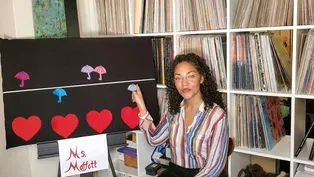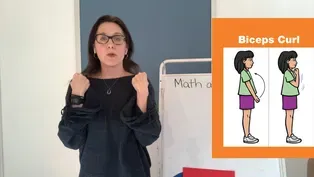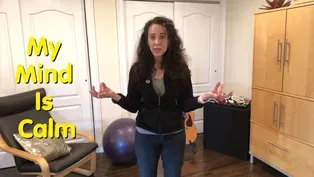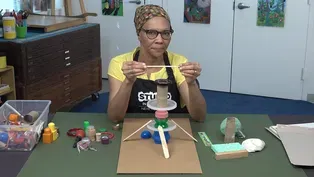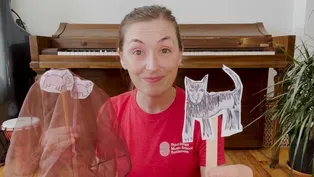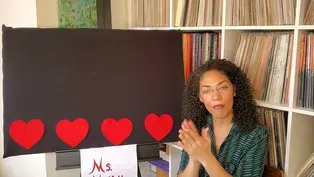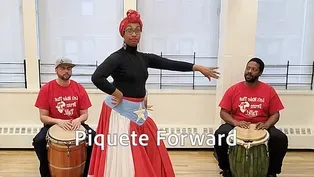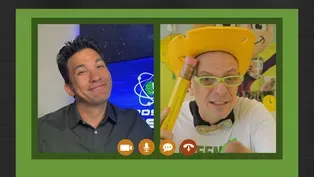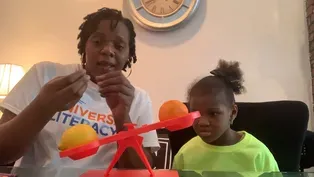
What Sounds Do You Hear in Square?
3/5/2021 | 55mVideo has Closed Captions
Transform paper, learn about building façade shapes, read FRIENDSHAPE.
Transform paper, learn about building façade shapes, read FRIENDSHAPE, segment sounds and review initial blends with s. LET’S LEARN helps children ages 3-8 with at-home learning. One-hour programs feature instruction by educators and virtual field trips.
Problems with Closed Captions? Closed Captioning Feedback
Problems with Closed Captions? Closed Captioning Feedback
Let's Learn is a local public television program presented by THIRTEEN PBS

What Sounds Do You Hear in Square?
3/5/2021 | 55mVideo has Closed Captions
Transform paper, learn about building façade shapes, read FRIENDSHAPE, segment sounds and review initial blends with s. LET’S LEARN helps children ages 3-8 with at-home learning. One-hour programs feature instruction by educators and virtual field trips.
Problems with Closed Captions? Closed Captioning Feedback
How to Watch Let's Learn
Let's Learn is available to stream on pbs.org and the free PBS App, available on iPhone, Apple TV, Android TV, Android smartphones, Amazon Fire TV, Amazon Fire Tablet, Roku, Samsung Smart TV, and Vizio.
Providing Support for PBS.org
Learn Moreabout PBS online sponsorshipMore from This Collection
Video has Closed Captions
Read SCHOOL BUS and draw one, learn about prefixes and pitch, build sculptures. (57m 48s)
Running and Counting Both End in “ing”!
Video has Closed Captions
Move to improve, find the missing number, learn songs from Ghana, read ABUELITA’S SECRET. (58m 17s)
What Sound Does “aw” Make in Draw?
Video has Closed Captions
Read a story, discover "au" and "aw," learn about density, count, and move with music. (56m 58s)
Can You Find the Short “u” in Subtract?
Video has Closed Captions
Help Super Grover 2.0 solve a prickly problem, read ALL THE WAYS TO BE SMART. (56m 19s)
What Sound Does “gl” Make in Glove?
Video has Closed Captions
Play the glockenspiel, help Super Grover 2.0 make a cart move, read TWO WOOL GLOVES. (58m 9s)
Incredible Starts with Short “i”!
Video has Closed Captions
Solve problems with Super Grover 2.0, catch a rainbow, hear a piano sound like a cuckoo. (56m 9s)
What’s the Sound of “oo” in Book?
Video has Closed Captions
Explore animals’ form and function, sing about the 3 little pigs, read THE LITTLE BOX. (58m 15s)
We’re Reducing, Reusing and Recycling!
Video has Closed Captions
Learn all about rhythm and the number 9, read A BAG IN THE WIND. (56m 17s)
Video has Closed Captions
Learn to dance bomba and grow food in a city, read WOLF CUB’S SONG. (55m 20s)
How Many Syllables are in Invent?
Video has Closed Captions
Invent your own instrument, make 10 to add numbers to 20, read ONE GOLDEN RULE AT SCHOOL. (57m 36s)
Video has Closed Captions
Learn about the science behind mind reading, count shells, read MY BIG FAMILY. (57m 27s)
Which is Heavier: One Apple or Two Apples?
Video has Closed Captions
Defy gravity, learn secret code words for fast and slow in music, read WHOOO KNEW? (58m 5s)
Providing Support for PBS.org
Learn Moreabout PBS online sponsorship[upbeat music] - [Host] Ready to learn?
- Hi.
- [Host] It's time to share a story, read and write.
- Let's read it back.
- [Host] Discover science, sing, - Some, play, - [Host] And so much more.
- Okay.
- [Host] Stay tuned for lessons and activities.
- We're gonna start making some words.
Isn't that fun?
[upbeat music] - [Host] Funding for this program was provided by the JPB Foundation.
[upbeat music] - Hello scholars, Welcome to a wonderful day of learning.
My name is Anna and I am so excited to be here today to read a story with all of you.
Now, before we read this story though, I want you to think of a friend that you have.
Who is that person?
What makes them your friend?
Now it could be a family member like your mom or your dad, your brother, or sister, a cousin.
It could be a neighbor that lives down the hall.
It could be someone that lives in another state and you don't get to see them that often but every time you talk to them, they make your heart happy.
Well, I want you to think about this person today as we are reading this story together and it's called Friendship.
An uplifting celebration of friendship.
From the New York Times Bestseller Team, Amy Krouse Rosenthal and Tom Lichtenheld.
Friends shape who we are.
Friends shape who we are.
Do you know what that means?
Tell a trusted adult near you.
What do you think, friends shape who we are means?
So when I hear that, I think it means that friends make us better.
That is one friend is doing something that's really great.
And then I started to do it too.
They just helped shape who I am.
They made me a better person Friend Shape by Amy Krouse Rosenthal and Tom Lichtenheld.
And it says that there are friends... Oh look the shoes are talking.
We're good buddies, four amigos!
Great pals!
Besties!
What's so great about having friends?
We're glad you asked.
See the great thing about having friends is everything!
Friends make you feel happy.
Okay remember I told to think about a special friend.
Think of something that they've done that's made you happy and tell that to the adult next to you.
So the friend that I'm thinking about her name is Nina.
And whenever I'm feeling sad, she always gives me a phone call and tells me a funny joke to make me feel better.
Friends make you feel at home.
Welcome!
We rolled out the red carpet for you!
Friends know how to make their own fun.
Faster!
Faster!
You guys are wearing me out.
You're gonna be a wrecked angle!
Friends play fair and square.
Your turn next, okay?
What's something that you like to play with your friends.
I just love going outside on hikes and going for walks with my friend.
It gives us time to just talk and be together.
Friends Sometimes think the exact same thing at the exact same time.
Banana.
Friends welcome others to join in.
So glad you could stop by.
Friends may quarrel.
What does that mean?
Friends may quarrel.
Have you ever heard that word before?
What do you think it means?
Well, let me read what they're saying and let's see if we can figure it out.
- Are so.
- Am not.
- Did so.
- Did not.
- It seems like when you quarrel that means you're fighting with someone.
Have you ever had a quarrel with your friend?
Me too.
But they don't stay bent out of shape for long.
I'm sorry.
Me too.
You know, you may have a good point.
So even though sometimes friends may quarrel it doesn't end their friendship.
They always find a way to make up.
Friends will follow each other to the moon and back.
Friends stick together for all of life's ups and downs.
Friends are always there for you to lean on.
Thanks again for your support!
Friends are a gift, because they fill our lives with joy and love.
Look how the four shapes were used to make the word love.
The rectangle makes the L, the circle makes the O, the triangle makes the V and the square is making that E, for LOVE.
Friends to the end.
I absolutely love this book.
Now, remember I told you to think about that friend of yours.
We're gonna do something special for them.
What I want you to do, is go find a piece of paper and a pencil and come meet me back here.
All right.
Go.
[upbeat music] Okay.
Welcome back.
So you have your paper and your pencil.
Now, what we're gonna do is we're going to draw a picture for our friend.
Remember that friend we've been thinking about this whole time.
But we're gonna use it using the shapes from our friendship book.
So what were the four shapes that we saw in the Friendship Book?
That's right.
We saw a triangle.
We saw a square.
We saw a circle.
And we saw a rectangle.
So now using those four shapes, we're going to make a picture for our friends.
I'll show you how.
So here's my paper.
And what I want to do is I want to make a flower for my friend.
So, to start off my flower, I'm gonna start off with my rectangle.
And my rectangle is kind like the STEM.
See, that's my rectangle.
Now, I'm going to use my square as kind of like the leaves on the side.
So I'm gonna make one square here, and make one where up here.
So it's like the leaves on my flower.
Then I'm going to use my circle, for the middle of my flower.
How are you doing so far?
Give me a thumbs up.
Great.
All right.
Now this is the fun part.
I get to make triangles all over around the circle to make the flower.
So here's one triangle and I'll make another triangle and I'm gonna go all the way around my circle until it's all filled up with triangles.
like these are the pedals of my flower.
Neat right?
Now, once you have all of your triangles around, don't forget to sign your name on the bottom 'cause you want your friend to know that you made it for him.
So I'm gonna write my name right at the bottom, and then if I have some time later on I'm gonna go back and color in my picture and then I'm gonna send it to my friend.
What you can do is you can give your picture to your friend that you were thinking of.
So if you were thinking about your mom or your brother or sister, you can give this to them.
And I guarantee you it's going to brighten their day.
Well scholars , I had so much fun reading the book, Friendship with you, and drawing our picture for our friends.
Until next time scholars.
Be safe, keep learning and have fun.
Bye.
- Hi, this is Violet.
Nice to see you movers and shakers.
All right, now I'm gonna sing a song about being happy.
Will you sing with me and do the movements.
♪ If you're happy and you know it clap your hands.
♪ [claps] ♪ If you're happy and you know it clap your hands.
♪ [claps] ♪ If you're happy and you know know it ♪ ♪ and your face will surely show it.
♪ ♪ If you're happy and you know it clap your hands.
♪ [claps] ♪ If you're happy and you know it stamp your feet.
♪ [feet stamps] ♪ If you're happy and you know it stamp your feet.
♪ [feet stamps] ♪ If you're happy and you know it ♪ ♪ then your face will surely show it.
♪ ♪ If you're happy and you know it stamp your feet.
♪ [feet stamps] Thanks everyone.
[upbeat music] - Hey learners, my name is Trinette.
- Hi, my name's Layla.
And we're so excited to be working with you all today for our phonics lesson.
Let's begin.
The only thing you will need today are your ears and your fingers.
So I want you to be able to listen to the things that I'm saying and you're gonna need your fingers to count.
So for the first activity, you're going to segment words into individual sense.
Here's what that means.
I'm going to say a word and you are going to count each individual sound that you hear.
Layla and I will do the first one as an example.
He is the word, sent.
I'm going to say each sound.
I'll do it again.
So let's come again, sent.
Layla, how many fingers did you count?
- Four.
Or how many fingers did you put up?
Four.
So Layla put up four fingers.
One for each sound that she heard, sent.
Okay, so now it's your turn.
I'm going to say a word then their sounds.
And I want you to count and tell me how many sounds you hear.
Learners are you ready?
Great.
Here's the first one.
Pie.
How many sounds do you hear in the word pie?
Great.
Layla how many sounds did you hear?
- Two.
- Two sounds is correct.
Here's the next one?
Spy.
How many songs did you hear in the word spy?
Did you say three?
Great job.
Here's the next one?
Lip.
How many sounds did you hear?
Layla how many sounds did you hear?
- Three.
- Great.
Now Layla and I will say some more words and we're going to say each individual sound.
Here's the word.
Step.
How many sounds did you hear?
Show me with your fingers.
Layla, show them with your fingers.
Four, great.
So Layla, you and I are gonna do a few more for them and we're going to say each individual sound.
Okay?
- Okay.
- Here's the word?
Sleep.
Let's say each individual sound.
I want you guys to listen.
How many sounds did you hear?
Okay Layla, you're now gonna hold up your fingers to show them.
Ready, set, go.
Perfect.
I heard four sounds so did Layla.
Here's the next one.
Steak.
How many sounds did you hear in the word steak?
Great.
Layla let's show them what we heard.
Perfect.
Four sounds.
Here's the next one, take.
Are you ready?
Take - Take - How many sounds did you hear?
Let's do that again.
Take.
- Take How many sounds did you hear in the word take?
Let's show them.
Great we heard three sounds.
Here's the next one, sub.
let's say individual sub for them.
Sub.
- Sub.
Learners, how many sounds did you hear in the word sub?
Show me using your fingers.
Great job.
Layla let's show them.
Perfect, three sounds.
Great job learners.
You were able to hear the sounds in a word and count them.
Pretty good job.
Let's move on.
Now we're going to practice blending.
Let's review a few of our letter cards.
I have one diagraph here and it's sh, as in sh, ship.
My next diagraph is th as in th, thumb.
And I also have the constant here which is the letter s, as in s, snake.
So Layla is going to hold up the board, and on the board, you will see a few words.
Let's move a little closer so our learners can see.
And I'm going to touch each card and say the sound that it represents.
For example, thud.
Now I'm gonna blend them, thud.
One more time, thud.
So here's the next one, fish.
Now I'm going to blend those sound cards together, fish.
Let's do that one together again, fish.
Now learners at home, I want you to try...
I want you to try the next one.
I'm going to touch each card and you're going to say the sound and then try to blend them together.
Great job.
Yeah you were able to blend them.
Layla and I will do the same thing.
Let's go Layla, slim.
- Slim.
Great job.
Now what we're going to do next is something called blending lines.
So we're going to remove our cards from here.
And we're going to practice reading some more words and looking for some things that are common with those words.
So, here's our blending lines and I want you to look at line number one and let's read them, smell, spill, snap, spin, and stuff.
What do you notice about line one?
Do you see any words that something in common?
I do.
In line number one, I see that smell and spill both have the same ending.
And I also see that spill and spin have this same blend of s and p. Now, we're going to read line number two.
So let's zoom in.
It is shin, thin, shop, stop and step.
Do you notice anything about any of the words in line number two?
I'll give you a moment.
I noticed that sharp, stop and step all end with the letter p. Do you see that in line number two?
Great.
Now we're gonna jump down to line number five.
It says Dad, Stan and Beth pack bags.
Again Dan, Stan and Beth pack bags.
Do you notice anything about line number five?
I noticed that Beth and bags both begin with the letter B.
Let's scroll down to line number six.
They will have fun in the sun.
Can you see that?
They will have fun in the sun.
Do you notice anything about line number six?
Yes.
Fun and sun both end with the same ending sound which is the letter n. Great job.
Now, we have one final activity.
Layla is gonna scoot over and so am I.
And this is something that I want you learners to do at home.
So we have a word bank, and the words on top in black, are the words that we're gonna use and place down here next to the words that are red.
We're looking for the rhyming word.
So for example, the first word I have here is mop.
What's the word, - mop.
- Mop.
Now, once I look at all of my words in my word bank, which are black.
So I have splas.h stab strum, thick, last, skip.
Let's think about this.
Layla, which word in our word bank do you think belongs next to the word mop and that it rhymes, which one?
- Stop.
- Great.
So I'm going to take the word stop, and place it next to mop.
And that is a set of rhyming words.
So learners, we have five more words and I want you to help Layla and I find the rhyming words for the words that appear in red.
So here's the next one.
Ship.
Learners, what word in the word bank rhymes with ship?
Let's just take a look.
Here are the words we have remaining.
Splash, strum, stick, last, skip.
Learners what do you think rhymes with ship?
Oh, you are correct, skip.
Great job.
So I'm going to take skip and put it next to the word.
We have a few more, slick.
What rhymes with slick?
Take a look at the words we have remaining in black.
Did you say thick?
Great.
Layla what do you think?
Do you think is thick as well?
- Yes.
- Okay Layla's gonna place thick next to slick.
And we have three words remaining and which we need to find the word that rhymes with it.
We have fast.
What rhymes with fast?
Think about it.
Tell me at home what do you think is the word that rhymes with fast?
Great.
You said last.
Layla can you take last and place it next to fast?
We have two more words to go.
You guys are doing a fantastic job.
Cash.
What rhymes with cash?
Take a look at the two words that are remaining.
Tell me what you think it is.
Yes.
Splash.
Layla will take the word splash and put it next to cash.
Which now leaves us with one word left in our word bank and one word left below.
So we already know that this is a match.
So let's blend it.
The sounds form a word, hum.
Which rhymes with strum.
So Layla's gonna take strum and place it down below next to the word hum.
Okay, go ahead.
So learners, you were just able to read words and find a matching pair or a matching set of words.
And you did a fantastic job with that.
Okay learners, thank you so much for working with us today.
I hope you were able to learn something new.
And so we meet again.
Bye bye for now and see you soon.
Bye.
[upbeat music] - Hi, I'm Andrew and I am back with another activity about the building environment in your community.
Today we're going to be talking about a very important part of a building and we call it the building's face because it's the outside or the front of the building.
The first thing that you see when you look at a building from the outside.
And that word sounds a little bit like face it's called the buildings facade.
So we are gonna be talking about building facades today.
Today, we're going to talk about the different shapes that make up the facade of a building.
Can you think of some shapes?
How many different shapes can you name?
Maybe you're thinking about a rectangle or square or a triangle or a circle, or maybe another shape.
There's many many different shapes that make up the built environment and make up facades of the building.
Now let's look at some examples.
We're going to look at some of the parts that are commonly found in facades.
And we're gonna look at what shapes make up those parts.
[upbeat music] Here is a picture of one part of a facade.
This is called the cornice.
The cornice is like a crown at the top of a building.
What shape do you see in this cornice?
[upbeat music] This cornice is a rectangle.
It's got four sides, two short sides and two long sides.
Next we're going to look at another part of a facade.
This one is also at the top of a building and it's called the pediments.
What shape do you see here?
You can count the sides.
There are one, two, three.
So this is a three-sided shape which is called what, a triangle?
So this one, the pediment is the shape of a triangle.
And let's look at one more.
This is a part of the facade called a dentil.
Dentils make a row along the outside of the building.
Here's another shape with four sides but all the sides are the same length.
What's that shape called?
This one is an example of a square.
So dentils have a square shape on the outside of the building.
Let's look at another facade and see how many different shapes we can find in this building.
When you look at this building's facade, what shapes do you notice?
[upbeat music] I can see rectangles.
I can see circles, one that we didn't talk about yet.
Squares, and maybe there are other shapes as well that you noticed.
In our activity today, you're going to be making a collage.
Do you know what a collage is?
Maybe you've made a collage before.
A collage is a picture that is made by taking pieces of paper or another material and sticking them or gluing them to a piece of paper.
So you are going to make a collage picture of a building's facade.
You can choose any building that you want.
It could be a building that you make up but you're going to choose a type of building and then create a picture of the outside or the front of that building.
And to do this, you're going to use paper.
So I have here a bunch of different kinds of paper.
I have some tissue paper.
I also have some colorful construction paper.
I have some plain white paper.
And I also have a piece of cardboard.
You can use any paper that you have.
And what you're going to do is you're going to need a piece of paper to be the background.
So it's something that you can glue the shapes onto.
And you're also going to need to make some paper shapes.
Here are some shapes that I have made using different kinds of paper.
Like I have this one, what shape does this look like?
Two short sides and two long sides.
So this one is a rectangle.
Or I have this one that I've made, which is a...
This one has three sides.
That's called what?
This one is a triangle.
You could ask an adult to help you using scissors to make the shapes, or I can show you how to make the shapes without using any scissors.
For this collage, I have decided to use the cardboard as my background.
So the cardboard is gonna be the paper that I'm gluing all the other shapes onto.
And then I have my other materials.
I have here my different shapes that are made from different types of paper.
I also have scissors, which as I said you don't need the scissors 'cause I'm gonna show you how you can make shapes without using them.
And I also have a glue stick to stick the shapes onto the paper.
You could also use tape if you don't have glue.
And if you don't have glue or tape, you can still make a picture out of the shapes.
On another piece of paper, you just won't be able to stick the shades down and save the picture.
So to start out, I'm going to show you how you can make shapes without having to use scissors.
So here is a piece of paper.
I'm going to make a four-sided shape.
That is about the same on every side.
So that's going to be a square.
So to make it, I'm gonna fold it.
I'm gonna fold it in the same place on both sides.
So now I have this paper has been folded in the same place on both sides.
And then once I do that, I can very carefully just tear the paper where I made those folds.
So now I have a rectangle but I want this to be a square and wants it to be either.
So I'm going to do the same thing.
I'm gonna fold it on both sides.
And then I'm going to very carefully tear along where I fold it.
So like I said, this is how you can make a shape without using scissors.
So for my facade the first thing I wanna do is I have to decide what type of building facade I'm going to make.
I'm going to make a house which is a place where people live.
So the first thing I'm going to do is I'm gonna put down a large shape to make my front of the house.
So this is... What shapes would we say this one is?
It's got two sides that are shorter and two that are a bit longer.
So this one is a rectangle.
So I'm just putting some glue on the back of this rectangle.
So what I've done is I have glued my rectangle down to the cardboard.
And this is going to be the main shape of the facade of the house.
Let's add some of those other features that we talked about that.
That facades might have on them.
There's one feature.
That's like a rectangle that's sits at the top of the facade, kind of like a crown.
You remember what that one was called?
That one is the cornice.
So I have a rectangle here which happens to be made using another piece of paper.
However, what is wrong with this shape as a cornice?
Looks like it's not long enough to go all the way to the end of my facade.
So what I'm going to do is I'm going to take another rectangle and I'm gonna put them both together.
So I'm going to glue down both of these so that we can create a cornice shape that is large enough.
So let's just put some glue on the back.
You can take the different shapes that you made and you can fit them together like this to create a larger feature of the facade.
What else does the facade mean?
People that live in the house probably need something that they can see out of, right?
So what can we give so that they can see out and so that they can have sunlight coming in.
Let's give them some windows.
I'm gonna use a different type of paper for the windows.
This shape, I think is a little too big.
Let me see if I have a smaller one that I can use.
You can also always change the size of any of your shapes if you think that they're not the right size for the facade in your picture.
So here are two smaller triangles.
Let's use these to make the windows.
If you have more than one type of paper, like I'm doing, you can use as many different ones as you want.
And you'll notice that they will look very different in different parts of your collage.
Now, the next thing that we're going to add we need something for people to get in and out of the house which would be what?
What feature of the facade would that be?
A door.
So let's make a door.
For this one, what shape is a door usually?
Usually when we see a door, it's going to be a rectangle, right?
This one looks like it's about the right size to be a door to this house.
So we can put the rectangle there to be the door.
[upbeat music] I would also like to add one of the other features that we talked about.
Do you remember the feature that looks like a row of little squares?
Those are called dentils.
So let's add some dentils.
I have some small squares that I've cut out.
So I'm going to use these.
I'm going to make a row underneath the cornice and I'll just put some glue there.
And now I'm going to put down some different squares.
All right, so here is the final facade.
I've used a bunch of different shapes.
I use different types of paper so you can decide what type of facade you want to make and how you want to decorate it for your collage using whatever paper and materials that you have.
What kind of facade did you make in your collage?
How did you make the shapes and what different shapes did you use?
Were you able to use different colors in your facade?
Once you finish your collage, you can add another building because your community has many different types of buildings.
So your picture can have more than one type of building as well.
You can also look for different other materials that you could use to make a collage.
A material that you haven't used before.
Join us next time for another activity about the built environment and your community.
Bye.
[upbeat music] - Hello everyone, welcome to the Memphis Zoo.
Here in the city of Memphis, Tennessee.
My name is Chelsea and I'm an Animal Interpreter here at the Memphis Zoo.
And in today's episode, we'll be diving into the topic of water.
Now humans use water for hydration but we also need it for a lot of other things too.
Like playing, bathing, cleaning, and more.
Can you think of all the different ways you use water?
Well, while you do, follow me.
[upbeat music] While you were thinking of all the ways you use water you may have realized how integrated it is into our lives.
Water is just as important for animals as it is for us humans.
An animal might need water to stay hydrated.
They may need water to stay cool on a hot day but some animals actually spend their whole lives in the water.
How about we go inside the aquarium and meet some of those animals.
Come on, let's go.
You and I have lungs to breathe, but fish are different.
They breathe through special organs called gills.
When a fish opens its mouth, it takes water in.
This water goes to get filtered through the gills.
The gills absorb oxygen from the water and push out carbon dioxide.
This is the process in which fish breathe.
Gills can not work out on land.
So fish needs to live in the water to survive.
Depending on the native range of the fish, some fish needs to live in cold water, and some need to live in warm water.
And depending on the salt concentration a fish's body adapted to, some fish need to live in salt water and some need to live in fresh water.
Different types of fish may require different conditions to thrive.
But the one thing that they all need stands the same, water.
[upbeat music] We just saw animals that live completely in the water but there are also animals that live both in water and on land.
These animals are called amphibians.
And the word amphibian means two lives.
And I bet you're wondering why.
Now that doesn't mean that they live twice, but that they spend half their life in water and half their life in land.
Amphibians like frogs and toads start their lives living in the water.
When a frog is born, it's called a tadpole.
Tadpoles have no legs, a tail.
And they breathe through gills in the water.
As the frog continues to grow, it loses its tail, grows legs and swaps those gills for a new pair of lungs.
This fascinating body change allows the frog to live out on land.
However, amphibians have special moist and slimy skin that can absorb water and oxygen.
So they'll spend their whole adult lives living by the water.
[upbeat music] For the amphibians we take care of at the zoo, we have to make sure they're always in a moist environment.
For example, Eric this moose sided toad gets his environment mixed it twice a day to make sure he doesn't get too dry.
We also change his water dish every day to make sure he has clean water.
Amphibians need access to clean water because it's very easy for them to absorb chemicals and pollutants through their skin that can make them sick.
If you have amphibians by your home, that might mean there's also clean water nearby.
This makes them an animal that can help tell us how healthy the environment is.
Animals that can do this are called indicator species.
[upbeat music] Not all animals that need water have gills or water absorbent skin.
Animals that live primarily on land like these hippos, use water to cool down on hot days or get protection from predators.
In Africa where temperatures can get pretty high, a hippo can spend all day relaxing in the cold water.
Now, despite weighing thousands of pounds, hippos are actually quite graceful in the water.
Now they can't swim, but they can walk and propel themselves underneath the water along the bottom.
Pointing their toes like train dancers.
They also use the water to protect themselves from predators that aren't as graceful in the water.
Like lions or hyenas.
Hippos can't breathe in the water, but they can hold their breath for up to five minutes under water.
They prefer to sleep in the water and while they're sleeping, they can float up to the surface, take a breath and then sink back down without even waking up.
It's amazing how hippos rely on the water to keep them healthy and happy.
Their name hippopotamus actually means river horse while they do love to spend time in rivers, they're not actually horses.
Some animals rely on water for safety but some animals rely on water for food.
Like our next step animal.
[upbeat music] Do you know what these are?
That's right.
They're penguins.
Penguins rely on the water to help them find their food.
Can you guess what they like to eat?
You got it.
Penguins love to eat fish.
So they depend on the water to give shelter to their food.
But the look of that waddling, you might've guessed that penguins aren't exactly quick when it comes to getting around on land.
In the water, they're much faster.
The fastest human swimmers can swim close to five miles per hour.
While penguins can swim up to nine miles per hour.
Those wide paddle like flippers make them powerful swimmers and their strong beaks helps them grip slippery fish.
They're perfectly adapted for moving around and catching their food and the water.
Like penguins, some people rely heavily on water for their food resources, like fish and selfish.
We also need water to nourish the crops that we grow and eat.
Can you think of a food you like to eat that comes from the water?
[upbeat music] Let's review today's lesson.
We learned that water is a basic need for animals and humans.
Animals use water for hydration, shelter, protection from predators, and so much more.
For the water to provide all these useful services to animals, it needs to be clean.
We play a huge role in keeping the water of the world clean.
By making sure our trash ends up in the proper disposal bin.
We're making sure that it stays out of the water and stays out of other habitats as well.
We can also make sure water stays clean and available to all animals by reducing the amount of water that we use.
Do you know one way we could use less water?
Yeah, that's a good one.
Another way we could use less water is by turning off the time when we're not using it.
[upbeat music] Well guys, it looks like it's time for me to go feed some of our animals.
But I had a great time talking with you all about the importance of water and the choices that we can make in our daily lives to ensure that all living things have enough water.
Again, thank you so much for spending the day with me at the Memphis Zoo.
Hope to see you next time.
[upbeat music] - Hi artists, I'm Belinda.
I'm a teaching artist with studio and a school.
Today we are going to explore different ways that we can change paper using just our hands.
The art materials that you'll need for this lesson are two sheets of paper that are different colors.
You can use notebook paper, you can use construction paper, you can use printer paper, or any other paper that you can find.
You will also need something you can put your shapes in.
Like a bowl or a plate.
How can we change this paper just by using our hands?
One way we can change this paper is by tearing it.
Do you know another word for tear?
Sometimes I like to say the word rip.
There are two ways to tear paper.
You can tear it fast or you can tear it slowly.
This is what it looks like when I tear paper fast.
When I tear paper slowly, I like to take my thumb and my first finger and put it on the paper.
Then I take my other thumb and first finger and pinch it and put it right next to my other hand.
Then I begin to tear the paper slowly.
I like to tear papers slowly when I wanna make a round shape.
Because I can turn the paper while I'm tearing, like this.
I often don't know what I'm gonna get.
What it will look like.
I'm gonna take my torn shape and just place it right on the table.
Now, I'm going to make six other torn shapes.
One, two, three, four, five and six.
I'm gonna take all of my torn shapes and put them in my bowl.
Now, let's look how we can change the paper in different ways.
I'm gonna take one of my torn shapes, and look at it.
I noticed that the paper is flat.
How can I make this paper stand up?
One way I can change the paper is two fold it.
I can take my shape and fold it in half.
Take hand and push it down to make a crease.
Ah, look, it's popping up.
I can even turn it this way on this side.
It looks a little bit like a tent.
I'm gonna put my folded paper over here.
I'm gonna show you another way we can fold paper.
I'm gonna take another one of my torn shapes.
I'm gonna fold it front and then I'm gonna fold it backwards.
And I'm gonna keep turning it and keep repeating folding it front ways and then back ways.
Front ways and then back ways until it's small like that.
And then let's see what happens when I open it.
Wow.
Look at that.
Look at that folded paper.
Does it remind you of anything?
It reminds me of stairs.
I'm gonna put my folded paper next to my other folded paper and take another torn piece from my bowl.
How else can I change this paper so that it's not flat anymore?
I can roll it, watch.
Like this.
Wow.
That really changed shape.
It looks like a tube.
I could even see through it.
And look what happens when I take my rolled paper and I leave it on my table without my hands.
It unrolls a little bit and it actually moves.
It rolls.
I'm gonna take another torn paper put it right in front of me.
It's flat.
How can I change it?
I'm gonna twist it.
Watch, watch my hands while I twist the paper.
Have you ever twisted paper before?
See how my hands are going in different directions.
There, that really changed shape.
I'm gonna move put that right next to my folded paper.
Now I'm gonna take another torn paper, this one, and see if you can tell me what I'm doing with my hands.
Watch.
What do we call that?
We call that crumpling.
We are crumpling the paper.
Sometimes you do that right before you put it in the recycling them.
Now it's like a ball.
I'm gonna take this paper and put it right next to my twisted paper.
And then the last way I wanna teach you guys how to change paper is called fringing.
When we fringe paper, we tear the paper slowly.
So I'm gonna take my thumb and my first finger, and my other thumb and first finger and put it together on the paper and tear it slowly.
And I'm gonna keep repeating it.
I'm not tearing it all the way.
Just a little bit, really slowly all the way to the end of the paper.
So it looks like this.
What does it remind you of?
It kind of reminds me a little bit of fingers or grass.
I'm gonna take all my shapes and put them in my bowl.
The next thing I'm gonna do is take my second sheet of paper, which is a different color.
I'm gonna take my purple construction paper.
This will be my background paper.
And now I'm gonna make an arrangement.
What is an arrangement?
An arrangement is taking your shapes and organizing them on your paper however you like.
I'm gonna choose five shapes for my bowl place them at the bottom of my background paper, let's see, I'm gonna choose my twisted paper.
I'm gonna choose my crumpled paper, my rolled paper, I need two more shapes.
I'll take my folded paper and my other folded paper.
Now I'm gonna make my first arrangement.
I'm gonna put my crumbled paper.
Let's see, I'll put it in the middle of my background paper.
And then I'll take my wallpaper and I'll put it in the corner over here.
Then I'm gonna take my folded paper and put it in the other corner of my background paper.
Then I'm gonna take this folded paper and I'll put it on like a tent on the other corner.
And finally, I'll take my twisted paper and put it in this corner.
I noticed something about this arrangement.
None of my shapes are touching.
Now, I'm gonna make a second arrangement.
Let's see what happens.
I'll take these off my paper, let's see how I will arrange them this time.
This time, I'm gonna take my folded paper and put it in the middle of my background paper.
And this time I'm gonna take my twisted paper and I'm gonna overlap it by putting it on top of my folded paper.
Now I'm gonna take my rolled paper and I'm gonna put it on the side of my folded paper and my twisted paper.
And now I'm gonna take this crumbled paper and I put it inside my rolled paper.
Look, you can't even see it.
And now I'm gonna take my folded paper and I'm gonna have it leaning on top of my rolled paper.
There, there's my second arrangement, this looks quite different than my first arrangement.
How are you gonna arrange your shapes?
Have fun.
Tearing, folding, rolling, twisting, crumpling and fringing your paper.
And I'll see you next time.
[upbeat music] Funding for this program was provided by the JPB Foundation.
[upbeat music]
Let's Learn is a local public television program presented by THIRTEEN PBS
